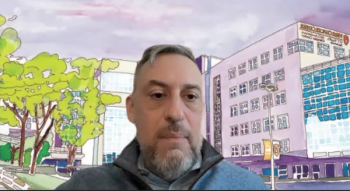
Dr Christopher Kane on Robotic Procedures in Prostate Cancer
Robotic procedures have really exploded in prostate cancer, said Christopher Kane, MD, professor of urology, University of California, San Diego. Robotic radical prostatectomy is now the most common way a radical prostatectomy is done in the United States.
Robotic procedures have really exploded in prostate cancer, said Christopher Kane, MD, professor of urology, University of California. Robotic radical prostatectomy is now the most common way a radical prostatectomy is done in the United States.
Transcript (slightly modified)
What are the advantages of robotic procedures over standard surgical procedures in oncology for outcomes and the recovery of patients?
Robotics is really a tool of laparoscopy, so robotics, and there’s really 1 big commercial robot, the Intuitive da Vinci Robotic System, really allows complex surgery to be done laparoscopically. The real advantage of the robot is better vision a 3-dimensional use of instruments. Standard laparoscopic instruments are sort of long instruments that don’t have joints to them, so the arms of the robot have the ability to manipulate. So, that allows really magnified surgery, very precise surgery, and a beautiful 3-dimensional image.
What’s really exploded is in prostate cancer. Robotic radical prostatectomy is now the most common way a radical prostatectomy is done in the US, and in much of the developed world. So, I think surgeons and patients have kind of spoken with their feet.
The main advantages are really bleeding; there’s very little bleeding, therefore very low transfusion rates. So, essentially, we don’t even make blood products available because the transfusion rate is now so low with experienced surgeons, and that low transfusion rate makes a difference. If someone has a high blood loss operation, they require transfusion, their actual infection rate’s higher and the hospitalization’s usually longer. So, being able to limit blood loss, limit blood transfusion really makes a difference for patients.
It may make a difference now in 30-day mortality, although patients dying after radical prostatectomy is fortunately exceedingly rare, it probably is even more rare after robotics. So, the rare patient that gets in trouble is someone who has a really difficult surgery, a lot of blood loss, an ICU stay, and those patients are at a little higher risk for negative events, which are fortunately quite rare.
So, I think radical prostatectomy, it’s really for the most part replaced open heart surgery. It’s probably not superior cancer control, the cancer quality is probably about the same as a well done open prostatectomy.
The main advantages are less pain, quick return to full activities, less bleeding, and therefore lower blood transfusion rate. Continence and potency recovery, the studies are a little bit mixed. Those of us who are enthusiastic, kind of robotics advocates, we think the data’s a little better for robotics. I think for continence, which is recovery of urinary control, 1 of the real risk factors for men is if they form a scar in the urinary tract called a bladder neck contracture, and that increases the risk of incontinence if that scar has to be treated, and the bladder neck contracture rate after radical prostatectomy robotically is much less than after open, and so it might be the advantage in continence is because of that lower bladder neck contracture rate. Potency, some would suggest is about the same as an experienced surgeon doing it open. My look at the data, it looks a little bit better robotically, although that’s an area of controversy.
Newsletter
Stay ahead of policy, cost, and value—subscribe to AJMC for expert insights at the intersection of clinical care and health economics.









































